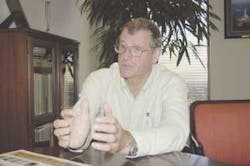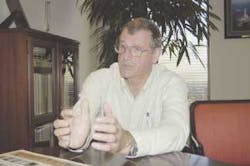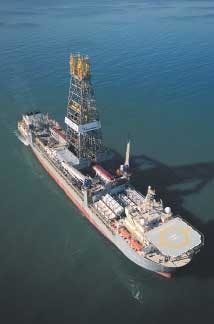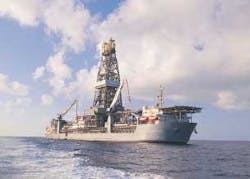Driller recalls 35 years of change
Robert J. Scott, senior vice president of operations for Transocean Inc., has seen a lot in his 35 years in the offshore drilling industry. In this exclusive interview, he talks with Offshore Editor Eldon Ball about how the industry has changed during Transocean's 50 years in the offshore drilling business and what he thinks might lie ahead.
Eldon Ball
Editor in Chief
How did you get into the drilling industry?
Scott: I went to work for a company named International Drilling Co. (IDC) who were operating land rigs in Libya. Later, I went with the same company to Kuwait, Saudi Arabia, and offshore Das Island, in the Arabian Gulf.
You moved around a lot back then?
Scott: Yes, and when you moved then, you actually lived in the country where you worked. Now, expat rig hands commute back to their hometown, but in those days, you were more like a camp follower. If you worked in Kuwait, you lived there. In the Persian Gulf, you lived right next to where the rig operated. If you were on a one-year or two-year contract, then you got a month off and started again. In the Far East, if the rig operated off Indonesia, you probably lived in Singapore.
I first worked on the drill crew and worked up through the ranks to toolpusher. In those days, the tool pusher was the man in charge of the rig. Back then, there was only one tool pusher. Now, we have two tool pushers – day man and night man – and we've added something called offshore installation manager.
How has the work changed for a drilling crew?
Scott: The biggest change is that there are a lot more specially trained people in the drilling process now. In previous times, the drilling crew did more of the non-drilling operations. When a wireline logging company came onto the rig, there was usually only one engineer, and he drove the truck. The drilling crew helped him – helped with his tools, and with setting up his work.
So, the drilling crew knew something about that side of the operation in addition to the drilling side. Then, as time went along, there'd be two engineers on the logging truck, and then three, and pretty soon the drill crew wasn't much involved. Same thing with mud engineers, cementing services, and well testing. It started to get very specialized.
Plus the economics have changed. When I first started, the day rate for an offshore rig was about $5,000 a day. Well costs were $3,000 to $4,000 a day. Wages on a drilling crew was about $130 a month.
By the same token, there was a lot of emphasis on the drilling crew. We tripped a lot because the bit didn't last long. There was a lot of emphasis on getting the bit in and out of the hole in the shortest time possible. Bits were selected by the toolpusher, and the emphasis was on downhole skills. A lot of drillers could tell you what was happening down hole, but they couldn't work it out for you on a piece of paper. They didn't rely on instructions from a lot of different people, they instructed themselves.
null
Something that happened quite often then that doesn't happen as often now is that toolpushers worked until the age of about 35 or 40, and then they went over to the operator side. Operators wanted someone who knew the business. So, naturally they recruited tool pushers.
I guess the biggest qualification for a toolpusher back then was experience.
Scott: That's right. But there's a lot more training these days. That's part of the progression that I talked about earlier, and we see even more of it today. You see crews come onto a rig and they've had some formal training before working on the rig.
The self-propelled jackup was a giant step at the time.
Scott: The Mercury was the first self-propelled jackup. Being self-propelled made it more mobile, easier to move from well to well. But it built complexity and more cost into the rig design, and if you weren't planning on moving the rig a great deal, it was an unnecessary expense. The Mercury worked in the North Sea, Argentina, North Africa, and Egypt. And it moved under self-propulsion to each location.
Drilling crews used to use spinning chains.
Scott: Yes, but that started to go out in the mid 1960s. It was – had the potential to be – a dangerous job, but if you had a good spinner on the crew, it wasn't as bad as it looked. Crewmembers knew they could trust each other. If you were working with a good crew, it wasn't that dangerous. Now that the crews are using a lot of mechanized machinery, they don't get the chance to develop crew coordination as previously, just because of the nature of the work. In fact, the mechanical pipe spinner slowed down the tripping operation somewhat, as using the manual chain was just quicker. But from a safety perspective, the mechanized version is an improvement.
Technically, offshore floating drilling was pretty simple in the early days – rotary table, kelly, rig tongs. The drillship Discoverer II came out with a design that was perfected in the mid 1960s where mechanical arms racked the pipe in the derrick. It was safer, and faster, and had advantages over the manual drill ship operation. Global Marine also had a system where they laid the pipe down on the deck, which was also a great innovation at that time. However the Discoverer II was the first floating rig with a derrick-mounted pipe racking system.
At that time, the going speed for tripping was about 55 stands of pipe an hour. The automated system could only do about 45 stands at best, so we took off some of the automated equipment to get it up to about 50 stands.
That technology was developed for Esso, ExxonMobil, with a requirement that it had to trip as fast but safer than a manual derrick.
Remember, we carried much lighter loads then. The industry was only out to about 600-ft water depths, and loads were about 350-500 tons. Then, as we started moving into deeper water, things started getting heavier. In shallower water, we had 5,000-psi BOPs. From about the 1970s, we started putting on 10,000-psi BOPs, because of deeper drilling and deeper water.
When the industry began moving into deeper waters in the 1970s, moving deeper than 600 ft, then we had to change the rig designs to accommodate that. I remember when the question was asked, what's next? Do we need something bigger? At that time, geologists were telling us that we couldn't go any deeper. Operators were telling us that they couldn't produce in water depths over 600 ft. Then drillships such as the Discoverer 534, were built. The Discoverer 534 started out as a turret-moored drillship with thrusters that could DP. Now it's strictly DP. But it was designed to moor in 3,000 ft, and people said, "What the heck do you want to moor in 3,000 ft? That's totally crazy." Since then, that rig has been bypassed by much bigger rigs. The industry can and will change to meet the needs of the times.
null
What about when things started moving to the seabed?
Scott: That was another big change, once we put the BOP on the seabed. At first, we were basically taking a land BOP and installing it on the seafloor. Therefore there were a number of metallurgical problems. We learned a lot, and the operators helped us. Esso was a very strong supporter of technology advances back then.
A lot of the changes in floating drilling materialized in Brazil and the Far East – Indonesia, Malaysia, Australia, New Zealand. Discovery wells from floaters were drilled in the Bass Strait and off New Plymouth in New Zealand, then, Peninsular Malaysia offshore Trenganu. There were a lot of offshore wells already drilled off Brunei.
What was the preferred type of rig in that part of the world, once you got out of jackup depth?
Scott: The semis were fine for a static area, like Brunei. But for those operators that had widespread prospects, a drillship began to be a preferred option because of its high mobility. You could move around better. But semis were preferred for floating operations in the North Sea. Southeast Asia was a good place for rigs that couldn't work in more harsh environments, like the North Sea.
Tell me about your work for India. Was this when the ONGC first started drilling offshore?
Scott: Yes, we built a rig for the Oil and Natural Gas Corp. of India. It was a four-legged jackup called the Sagar Samrat. That was in the early 1970s. We took it to India and trained the ONGC on how to use it. It's still there.
In those days you started off primarily with US crews, right?
Scott: They were mainly expatriate crews. When the floating drilling industry first started moving into the international arena, the crews were primarily expatriates, and then we started to get the local workforce involved. Like in Malaysia. We went there in 1969, and by the time the rig left in October 1975, we took five Malaysians with us who we'd trained.
null
When you compare those days with today's business environment, it's quite a difference.
Scott: Everything in technology has grown tremendously, both in size and in complexity. Today, the world water depth drilling record is 10,011 ft, set by the Discoverer Deep Seas. That dual-activity drillship and other fifth-generation units have hook loads exceeding 1 million pounds, very large deckloads, high-pressure mud pump systems, automated pipe-racking, the list goes on and on. Drillers and assistant drillers, again with a great deal of training and expertise, work in enclosed cabins with joysticks and touch-pad computer screens. DP operators keep these rigs precisely on location with advanced DP systems fed by information from satellites and acoustical beacons on the sea floor. Other rigs have innovative features such as off-line casing "mini derricks."
It's this combination of world-class iron, technology, training, and people that have set and will continue to set all kinds of records for our clients. For those reasons alone, it's exciting to be in the offshore drilling business. But when you add the fact that frontier deepwater provinces are becoming more active, it gets even more interesting. Malaysia, India, Eastern Africa, Mexico, and other frontier areas are advancing deepwater initiatives. That's not to say that older hydrocarbon fields do not have potential. As fields mature, there's greater demand for workover and in-field drilling, as we are experiencing with the North Sea. All told, these drilling requirements make for a very challenging business, and we're looking forward to continuously improving to meet and exceed clients' demands. Continuous improvement is the about the only thing that has not changed in the past 50 years of offshore drilling.



